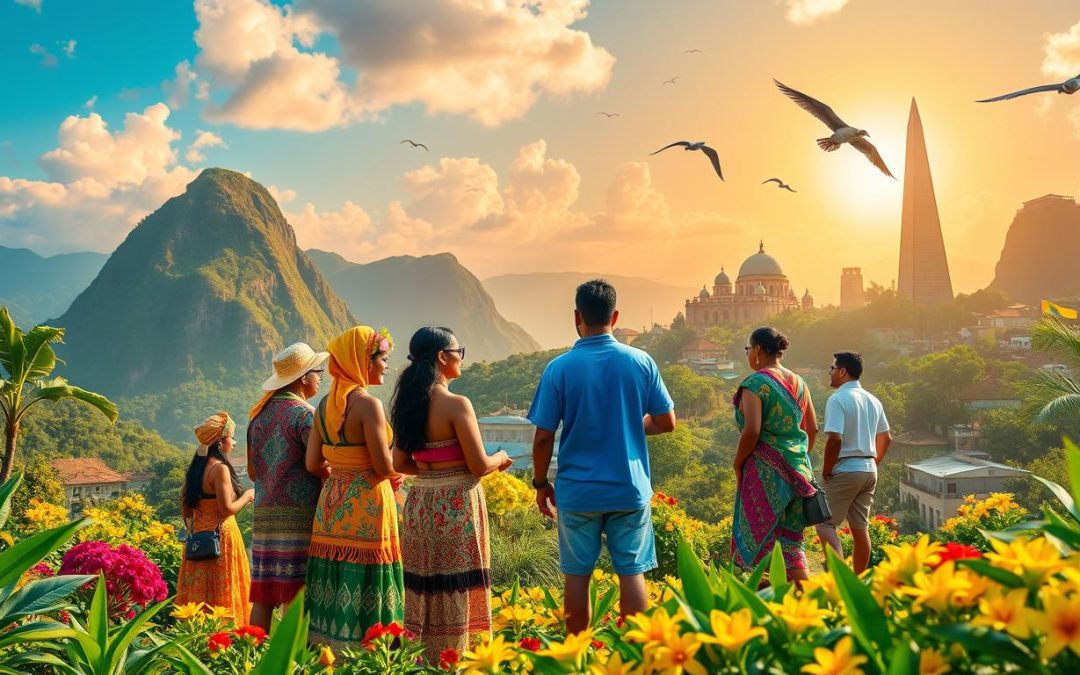Have you ever thought about how one country can have so many languages? Brazil is a great example of this. It has indigenous, colonial, and immigrant languages all mixed together.
In Brazil, language is more than just talking. It shows the country’s rich and complex identity. Portuguese is the main language, spoken by almost all Brazilians. It connects over 205 million people from different places and backgrounds.
Brazil’s language scene is very colorful. It has 238 languages, with 217 being from indigenous groups. This shows how people have adapted and survived through language over time.
Key Takeaways
- Portuguese is spoken by 99.5% of Brazil’s population
- Brazil hosts 238 languages, with 217 being indigenous
- German and Italian are significant minority languages
- Indigenous language preservation remains a critical challenge
- Linguistic diversity reflects Brazil’s complex cultural history
Understanding Brazil’s Linguistic Landscape
Brazil’s language scene is truly unique. It shows the mix of cultures and history over the years. This mix came from the interactions of indigenous people, European settlers, and immigrants.
Before the Portuguese arrived in 1500, Brazil was full of languages. About 6-10 million indigenous people spoke over 1,300 different languages. This made Brazil a place of rich multilingualism.
The Evolution of Language in Brazil
The story of Brazil’s language is filled with important moments:
- Pre-colonial indigenous linguistic diversity
- Portuguese colonial language integration
- Immigrant language influences
- Modern language adaptations
Cultural Impact on Language Development
Brazil’s language is a mix of cultural exchanges. Linguistic landscapes changed through:
- Native Amerindian language groups
- Portuguese settlers
- European immigrant communities
- African language contributions
Current Language Demographics
Today, Brazil’s language scene is interesting:
- 98% speak Portuguese as primary language
- Approximately 170,000 people speak 181 indigenous languages
- Significant minority language communities exist
“Language is the road map of a culture. It tells you where its people come from and where they are going.” – Rita Mae Brown
The Brazilian language scene keeps changing. It shows a dynamic mix of cultures and ways of communicating.
Portuguese: The Official Language of Brazil
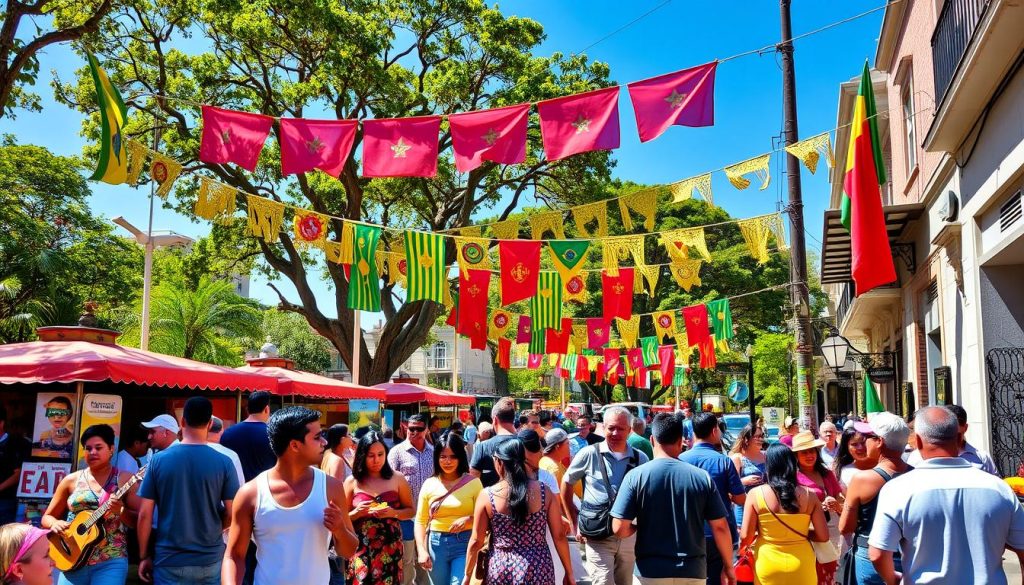
Portuguese is the official language of Brazil and plays a big role in the country’s culture and society. It has about 236 million native speakers, making it a strong language in South America. Almost everyone in Brazil speaks this lively language, making it the most common in the area.
In Brazil, the rights of Portuguese speakers are protected by the constitution. Brazilian Portuguese has its own special features that set it apart from European Portuguese. This makes it a unique part of Brazil’s identity.
“Language is the road map of a culture. It tells you where its people come from and where they are going.” – Rita Mae Brown
- Official language since Brazil’s independence
- Spoken by over 184 million Brazilian inhabitants
- Fifth most spoken native language globally
- Recognized as an official language in multiple international organizations
The history of Portuguese in Brazil shows the country’s complex past. It has changed over time, influenced by many cultures. This includes indigenous and African languages, making Brazilian Portuguese a vibrant and changing language.
| Language Statistic | Details |
|---|---|
| Total Portuguese Speakers | 264 million |
| Native Speakers in Brazil | 236 million |
| Global Ranking | 5th most spoken native language |
Learning Brazilian Portuguese is more than just talking—it’s a way to connect with Brazil’s heart. It shows the country’s rich culture and the importance of language. Whether you’re in São Paulo or the Amazon, the language links you to Brazil’s lively spirit.
Historical Development of Brazilian Portuguese
The story of Brazilian Portuguese is a journey of cultural change and adaptation. It shows how colonization, migration, and language diversity shaped modern Brazil. This journey is full of interesting twists and turns.
When Portuguese settlers came to Brazil in the 16th century, they brought more than just a language. They started a deep change in how people communicated across the continent. The mix of European, indigenous, and African cultures began to shape Brazil’s language.
Colonial Linguistic Foundations
The growth of Brazilian Portuguese was shaped by many cultural meetings. Important factors included:
- Interactions with indigenous languages
- Contributions from African languages
- Language exchanges with European immigrants
Modern Brazilian Portuguese Features
Brazilian Portuguese became a unique dialect with its own traits. Its development included:
- Simpler grammar
- Special pronunciation
- More words from indigenous and African languages
Regional Dialect Variations
Brazil’s large size led to many different dialects. Each region has its own way of speaking, showing off local culture. From the caipirês of rural São Paulo to the baianês of Bahia, these variations highlight Brazil’s language diversity.
*”Language is the road map of a culture. It tells you where its people come from and where they are going.”* – Rita Mae Brown
By 2022, about 203 million people spoke Brazilian Portuguese as their first language. This made it a lively, changing way to communicate that keeps growing.
Brazil: Official and Widely Spoken Languages
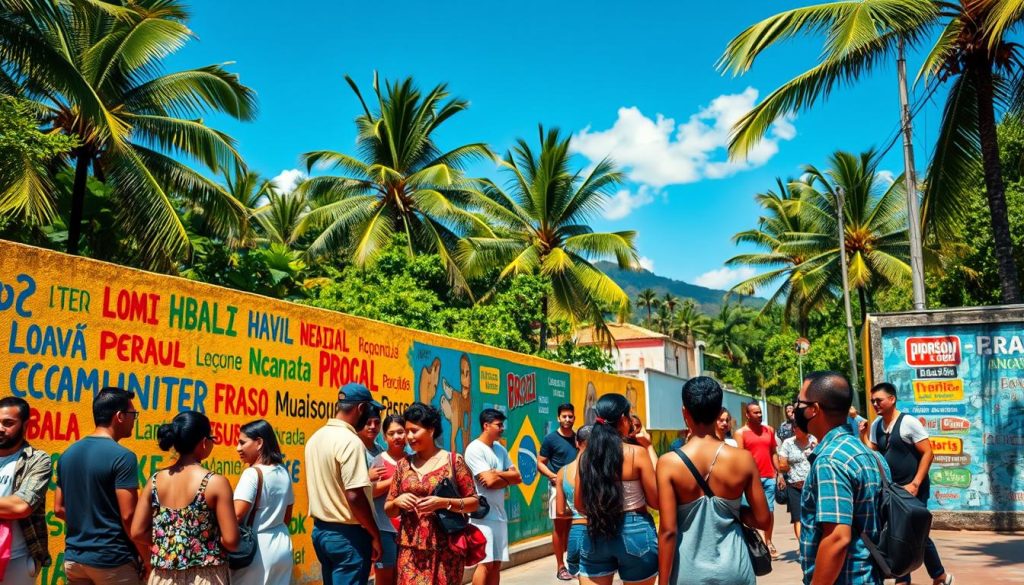
Brazil’s language scene is rich and complex. Portuguese is the official language, spoken by 99.5% of people. But Brazil’s language diversity goes beyond just Portuguese.
By 2023, Brazil had 238 languages spoken or signed. This includes:
- Approximately 217 indigenous languages
- Languages from European immigrant communities
- Asian language contributions
- Brazilian Sign Language (Libras)
The language mix in Brazil is fascinating:
| Language Category | Percentage of Speakers | Approximate Number |
|---|---|---|
| Portuguese | 98% | 204 million |
| German | 1.9% | 3-4 million |
| Italian (Talian) | Minority language | 1.5 million |
| Indigenous Languages | Less than 1% | 274 active languages |
The story of Brazil’s languages is one of migration, preservation, and cultural mix. Nheengatu, an indigenous language, is officially recognized in São Gabriel da Cachoeira. This shows Brazil’s dedication to language diversity.
“Language is the road map of a culture. It tells you where its people come from and where they are going.” – Rita Mae Brown
Exploring Brazil’s languages shows a vibrant, ever-changing scene. It celebrates both indigenous and immigrant cultures.
German and Italian Communities in Brazil
Brazil’s language scene is full of life, thanks to minority languages and cultural diversity. European immigrants, especially Germans and Italians, have greatly influenced Brazil’s multilingual nature. They brought their languages to South America.
German immigrants have had a big impact on Brazil’s language mix. About 1.9% of Brazilians speak German as their first language, second only to Portuguese. The southern states are where German culture is most alive.
Hunsrückisch German Dialect
The Hunsrückisch dialect is a great example of keeping a language alive. It comes from the Hunsrück region in Germany. In Brazil, it has changed, showing how the community’s journey has shaped their language.
- Primarily spoken in southern Brazilian states
- Developed as a result of immigrant community isolation
- Maintains strong connections to original German linguistic roots
Talian: Brazilian Italian Variant
Italian immigrants also enriched Brazil’s language scene. Talian, a special Italian variant, is big in Rio Grande do Sul. It’s even an official language in some places there. This shows how minority languages keep cultural identities alive.
Geographic Distribution of European Languages
The southern Brazilian states of Santa Catarina, Rio Grande do Sul, and Paraná are key for these European languages. Their presence shows Brazil’s dedication to language and cultural diversity.
“Language is the road map of a culture. It tells you where its people come from and where they are going.” – Rita Mae Brown
Indigenous Languages and Their Preservation
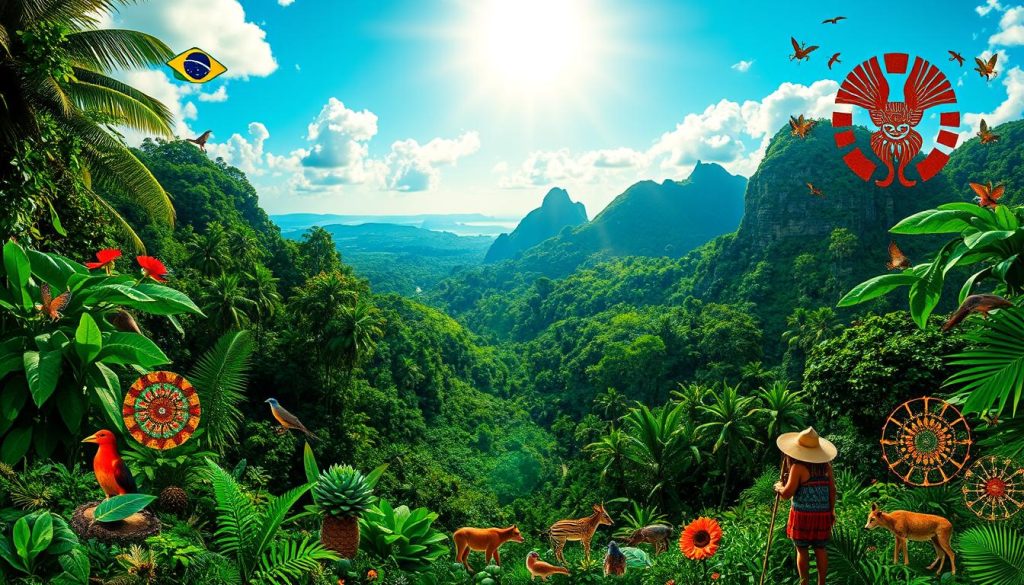
Brazil’s linguistic landscape is incredibly rich with indigenous languages. These languages represent a deep cultural heritage facing big challenges. Before Portuguese colonization, about 1,000 indigenous languages thrived. Now, around 274 languages remain, with over 100 at risk.
The linguistic diversity of Brazil’s indigenous communities is amazing. Today, more than 160 languages and dialects are spoken by indigenous peoples. They belong to 227 distinct indigenous groups. These languages fall into several fascinating linguistic families:
- Tupi linguistic branch
- Macro-Jê linguistic branch
- 19 recognized linguistic families
- Several isolated languages
Efforts to preserve languages are key to keeping cultural identity alive. Many indigenous communities show incredible linguistic skills. For example, Tukano people can speak three to five languages, with some knowing up to ten.
“Language is the roadmap of a culture. It tells you where its people come from and where they are going.” – Rita Mae Brown
Challenges in preserving indigenous languages include:
- Limited documentation of linguistic diversity
- Reduced number of native speakers
- Cultural assimilation pressures
- Lack of educational resources
| Indigenous Language | Region | Speakers |
|---|---|---|
| Ticuna | Amazon Region | Most widely spoken |
| Kaingang | Southern Brazil | Significant population |
| Kaiwá Guarani | Central-Western Areas | Strong community presence |
Understanding linguistic rights and efforts to preserve languages is crucial. It helps support the continued vitality of Brazil’s indigenous languages.
Impact of Japanese and Other Asian Languages
Brazil has a unique mix of languages, beyond just Portuguese. It has the largest Japanese population outside Japan, with about 1.5 million people of Japanese descent living there.
São Paulo is the heart of Asian languages in Brazil. The city shows how different cultures blend and languages are kept alive.
Japanese Communities in São Paulo
Japanese immigrants have greatly added to Brazil’s language diversity. They keep their culture alive through:
- Japanese-language newspapers
- Cultural centers
- Language schools
- Community events
Cultural Integration and Language Preservation
The Japanese community in Brazil is a great example of keeping languages alive while joining in with Brazilian culture. Their way of speaking multiple languages is very interesting to study.
| Asian Language | Estimated Speakers in Brazil |
|---|---|
| Japanese | 1,500,000 |
| Chinese (Mandarin) | Approximately 50,000 |
| Korean | Around 35,000 |
“Language is the road map of a culture. It tells you where its people come from and where they are going.” – Rita Mae Brown
But it’s not just Japanese. Chinese and Korean communities also keep their languages alive while becoming part of Brazilian society.
Brazilian Sign Language (Libras)
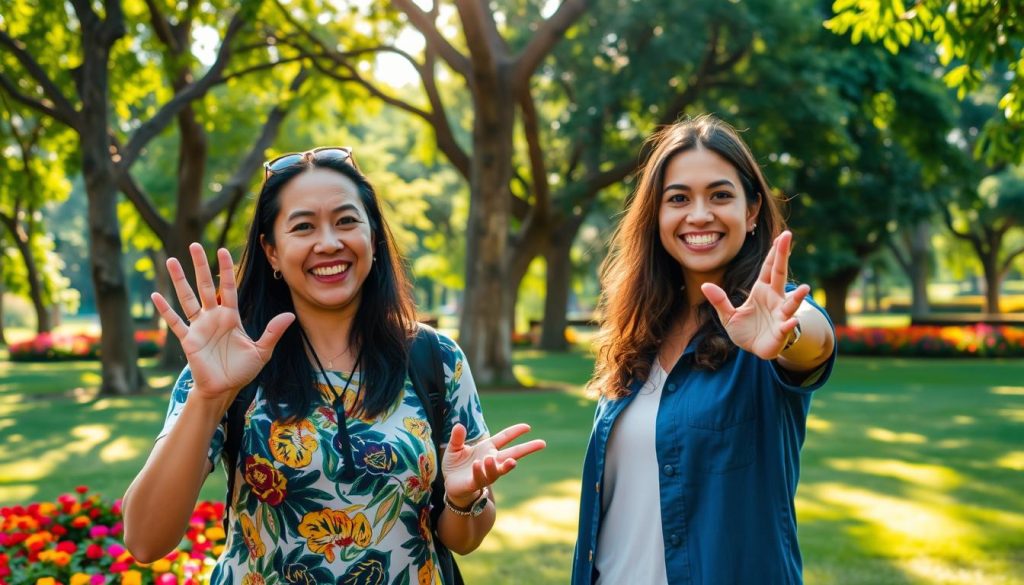
Brazilian Sign Language, or Língua Brasileira de Sinais (Libras), is a big win for deaf people in Brazil. In 2002, Libras was officially recognized as a full language. This was a big step for language diversity and cultural inclusion.
Today, Libras is used by about 630,000 people across Brazil. It’s a key way for deaf Brazilians to communicate. Libras is different from spoken Brazilian Portuguese because of its:
- 35 distinct hand positioning points
- 111 identified handshapes
- Rich visual grammar and expression
The National Federation of Education and Integration of the Hearing Impaired (FENEIS) helps spread Libras. They work in 11 places to support deaf education and rights.
“Libras is more than a language; it’s a bridge to understanding and cultural connection.”
Libras education started in 1857 with the first school for deaf students. The first Libras dictionary came out in 1875. This shows Brazil’s long commitment to this unique language.
| Key Libras Statistics | Data |
|---|---|
| Total Signers | 630,000 |
| Year of Legal Recognition | 2002 |
| Hand Positioning Points | 35 |
| Distinct Handshapes | 111 |
By making Libras an official language, Brazil supports language diversity. It also ensures deaf people have the right to communicate in their own way.
Language Policy and Education in Brazil
Brazil’s language policy is complex, with a mix of linguistic rights and multilingualism. The country’s schools struggle to handle its diverse languages. They aim to teach all languages well.
The National Inventory of Linguistic Diversity, started in 2010, is a big step. It helps protect and bring back minority languages in Brazil.
“Language is the roadmap of a culture. It tells you where its people come from and where they are going.” – Rita Mae Brown
Important parts of Brazil’s language education policy are:
- Teaching Portuguese as the main language in schools
- Keeping indigenous languages alive
- Learning foreign languages, especially English
- Working to make education fair for everyone
Brazil has made big progress in teaching languages. Here are some interesting facts:
- 97.9% of people speak Portuguese
- About 217 indigenous languages are still spoken
- English is the most popular foreign language to learn
The education system is changing. It’s working to make language policies that welcome Brazil’s diverse languages. This helps students get ready for the world.
Conclusion
Brazil’s linguistic diversity is truly remarkable. It goes beyond just speaking Portuguese. With over 205 million people, the country shows a unique multilingualism. This reflects its rich history and complex society.
Language in Brazil is more than just talking. It’s a living part of the nation’s multicultural identity. This shows how language connects people and cultures.
The story of Brazil’s languages is one of strength and change. Indigenous languages, European, and Asian dialects all play a part. Portuguese is the main language, but regional and minority languages are also valued.
This highlights Brazil’s dedication to language diversity. It shows how the country’s communication patterns are shaped by its history and culture.
Exploring Brazil’s language journey reveals its importance. Efforts to keep indigenous languages and support sign language show a national commitment. This ensures Brazil’s language heritage evolves while honoring its roots.
Looking ahead, Brazil is at a crossroads. It’s balancing language preservation with global communication. With literacy rates high and cities growing, Brazil is ready to celebrate its languages and connect with the world.
Your journey through Brazil’s languages shows a unique approach. It’s a dynamic, inclusive way of seeing language. This makes Brazil stand out globally.
The above is subject to change.
Check back often to TRAVEL.COM for the latest travel tips and deals.
Here are some Tours & Sightseeing suggestions that might pique your interests!
